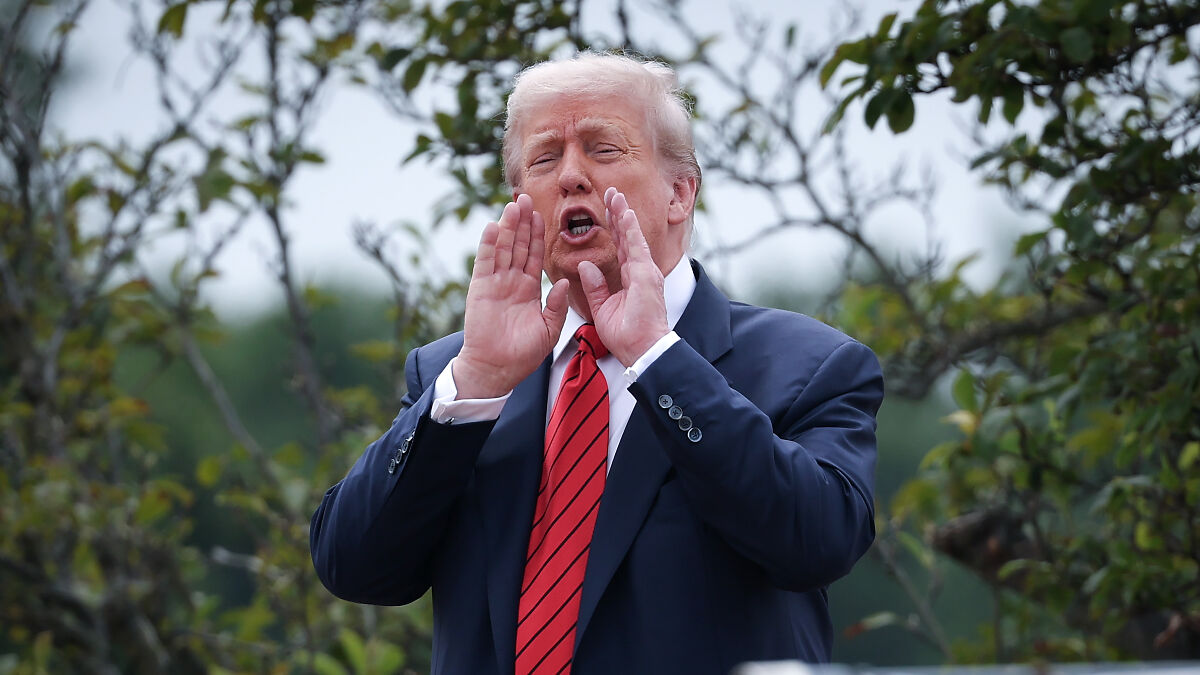U.S. President Donald Trump made an impromptu appearance on the roof of the White House West Wing on Tuesday evening, telling reporters he was surveying plans for new construction linked to his previously announced $200 million ballroom project.
He was walking above the briefing room while reporters watched from below.
“Just taking a little walk,” he shouted down when asked what he was doing.
- Trump appeared on the White House roof to discuss plans for a $200M ballroom and related new construction described as “something beautiful.”
- Trump claimed all financing of the ballroom project is from his own money.
- Lack of donor transparency raises concerns that the project could be a pathway for wealthy individuals to gain White House access.
“What are you building?” a reporter asked, to which Trump responded, “It goes with the ballroom, which is on the other side.”
He then called it “something beautiful,” while pantomiming with his hands.
From above, Trump told reporters he’s building something beautiful to go with his new ballroom
Image credits: Win McNamee/Getty Images
When asked what that meant, Trump said it was “Just more ways to spend [his] money,” addressing Fox News White House correspondent Peter Doocy, who called the moment “crazy.”
“It’s just another way to spend my money for the country,” Trump repeated.
Trump then ignored questions about whether he wanted to add another level to the White House, saying, “Anything I do is financed by me.”
“In other words, contributing. Just like my salary is contributed, and nobody ever mentions that,” he said as he walked away.
He said this, presumably referring to his 2017–2021 presidency, where he donated his official presidential salary. He has chosen to forgo his second-term salary as well, according to reports.
Later, he was asked again, “Mr. President, what are you trying to build?” To this, Trump replied, “Missiles, nuclear missiles,” he said, pointing towards the North Lawn.
Q: Sir, what are you trying to build?
TRUMP: Missiles. Nuclear missiles pic.twitter.com/1Iz8yyGkyY
— Aaron Rupar (@atrupar) August 5, 2025
Trump was joined by a small group of aides and architect Jim McCrery, who has been tapped to lead the ballroom project. The two appeared to be in animated discussions while pointing out features of the White House grounds.
The White House announced last week that construction will begin in September on a $200 million 90,000‑square‑foot ballroom designed to host large-scale events.
The ballroom will triple the current guest capacity of the executive mansion’s East Room and will be modeled after the ornate Mar‑a‑Lago ballroom.
The funding of the $200 million budget would be undertaken by Trump and other unnamed individuals. “I’ll do it and probably have some donors or whatever,” Trump said at a signing ceremony last week
However, from the rooftop, Trump claimed the project would be financed by him, taking all the credit and not mentioning any donors.
So far, the administration has not provided a list of contributors or explained how much of the cost Trump will actually cover.
This lack of transparency has fuelled concerns that the project could function as a way for wealthy individuals to buy favor or secure access to the White House.
The $200 million project has drawn criticism amid the Trump administration’s DOGE campaign
Image credits: The White House
Kathleen Clark, a law professor at Washington University in St. Louis, told The New York Times the lack of transparency was “completely outrageous,” and questioned whether the donors were seeking “ways to get in good with Trump.”
The ballroom project also raises broader questions about White House access. Lavish new event spaces could create opportunities for private gatherings or fundraising events that take place behind closed doors and away from the public eye.
Trump’s description of the project as “something beautiful” and a “legacy project” does little to address these concerns.
The issue echoes past controversies involving presidents’ private finances, including a 2021 controversy about Hunter Biden’s exorbitant art sales, where buyers’ details were kept anonymous.
Walter Shaub, who served as ethics chief under President Barack Obama, tweeted at the time, “So instead of disclosing who is paying outrageous sums for Hunter Biden’s artwork so that we could monitor whether the purchasers are gaining access to government, the [White House] tried to make sure we will never know who they are.”
Image credits: Win McNamee/Getty Images
The concern is similar now. If large sums are being donated for the ballroom, and those donors remain unnamed, it may be impossible to ensure they are not purchasing influence or favorable treatment.
Trump has long spoken about adding a ballroom to the White House, calling it a necessary upgrade for hosting state dinners and other high-profile events. He has also called it a “legacy project.”
Still, the optics of a $200 million expansion don’t match the reality on the ground, where many Americans struggle with rising living costs.




![Trump Hollers He’s Looking For “More Ways To Spend [His] Money” From White House Rooftop Trump Hollers He’s Looking For “More Ways To Spend [His] Money” From White House Rooftop](https://www.bpdaily.com/blog/wp-content/uploads/2025/08/GettyImages-2228651103-68931e5095013__700.jpg)
![Trump Hollers He’s Looking For “More Ways To Spend [His] Money” From White House Rooftop Trump Hollers He’s Looking For “More Ways To Spend [His] Money” From White House Rooftop](https://www.bpdaily.com/blog/wp-content/uploads/2025/08/white-house-state-ballroom-interior-view-looking-west-688c895ccda94__700-68931e5275d9f__700.jpg)
![Trump Hollers He’s Looking For “More Ways To Spend [His] Money” From White House Rooftop Trump Hollers He’s Looking For “More Ways To Spend [His] Money” From White House Rooftop](https://www.bpdaily.com/blog/wp-content/uploads/2025/08/GettyImages-2228649247-68931e4ce83c4__700.jpg)



15
1